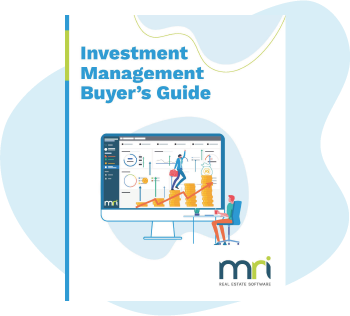Why CRE asset management software is critical for commercial investment success
The global real estate software market is projected to reach $15.8 billion by 2027. With property portfolios growing rapidly, effective management is more important than ever. For commercial real estate (CRE) investors and landlords, using the right CRE tools can streamline complex tasks and provide a competitive edge.
CRE asset management software centralises data, enhances collaboration and supports critical decisions, making it essential for your portfolio’s success. In this post, you’ll learn how CRE asset management software helps investors achieve greater returns by improving data analysis, reporting and communication.
What is CRE asset management software
CRE asset management software provides tools designed to simplify and enhance the management of commercial real estate assets. These applications handle tasks like lease management, budgeting, forecasting and financial analysis with greater efficiency. By consolidating vital data into a unified platform, the software helps property managers and owners oversee multiple properties effectively.
For large portfolio holders, CRE software ensures all critical information is accessible, organised and actionable. This centralised approach reduces the risk of missed opportunities and oversights in property management. Ultimately, CRE asset management software enables smoother operations and more strategic decision making.
Primary functions of CRE management software
CRE management software offers various core functions tailored to the needs of real estate professionals. Its CRE tools for lease administration let users manage leasing terms, renewals and rent escalations seamlessly. The software also supports financial modelling for assessing property performance, forecasting income and planning capital expenditures.
The software also enables comprehensive data analysis, helping users transform raw data into actionable insights. Key metrics like net operating income (NOI) and internal rate of return (IRR) are presented in intuitive dashboards for easy interpretation. With streamlined analysis, stakeholders can stay informed and make timely decisions.
Benefits of using CRE software
CRE software delivers numerous benefits, especially for managing multiple properties and handling complex data. Enhanced data analysis transforms raw figures into insights that support well-informed decisions, helping you optimise performance and adjust strategies effectively. Access to real-time data also lets you forecast market trends and refine your commercial real estate strategy accordingly.
CRE software enhances collaboration by enabling team members and stakeholders to access and update data simultaneously. This real-time communication reduces errors and keeps everyone aligned on project goals. With these advantages, CRE software helps reduce costs, improve efficiency and protect your investments.
Enhanced data analysis
One of the main advantages of CRE software is its ability to enhance data analysis. Instead of manually calculating metrics, the software provides insights into cash-on-cash return, cap rates and IRR for comprehensive property evaluation. This feature enables you to compare properties, assess financing options and evaluate new acquisition opportunities effectively.
Data analysis tools are also valuable for testing various financial scenarios, like leasing versus buying or refinancing versus selling. By quickly visualising these options, CRE software enables investors to make well-informed, strategic decisions. For serious investors, this analytical power is a game-changer.
Improved reporting and compliance
Keeping up with reporting and compliance requirements is crucial in CRE investment. CRE asset management software simplifies reporting by automating financial statements, occupancy records and compliance documents. This means that all critical information, from income summaries to rent rolls, is available on demand.
With automated reporting, you avoid the time-consuming process of manual data entry and ensure accurate, compliant documentation. For large portfolios, this level of efficiency reduces risks of oversight and potential penalties. CRE software supports a smooth, compliant operational framework minimising stress and error.
Streamlined communication among stakeholders
CRE software facilitates seamless communication among investors, managers and other stakeholders. By centralising data and enabling real-time updates, all team members have access to the same information, reducing miscommunication. Shared dashboards and automated notifications ensure everyone remains informed of critical developments.
In an industry where timing is essential, this level of collaboration can make a significant difference. Streamlined communication enables faster issue resolution and keeps projects on track. For investors with large portfolios, effective communication is key to maintaining alignment and efficiency.
The role of commercial real estate investment analysis software
Commercial real estate investment analysis software specialises in deep financial analysis and scenario testing. These tools help investors conduct thorough market research, compare property values and forecast future cash flows. By analysing metrics like cap rate, NOI and IRR, investors can identify lucrative opportunities and make data-driven decisions with the help of advanced commercial real estate investment software.
This software provides advanced modelling capabilities that support strategic decision making, letting users forecast expenses and income based on customisable scenarios. These insights are crucial for maximising returns and minimising risks, even in uncertain markets. With these capabilities, investors can gain a clearer understanding of potential outcomes and make well-informed choices.
Essential features of CRE analysis software tools
Choosing the right CRE analysis software tools means identifying features that align with your specific needs and investment goals. These tools should offer functionalities that support better decision making and improve investment outcomes over time. The best CRE tools also adapt as your portfolio grows, keeping you prepared for changing market conditions.
Key features to look for in CRE analysis software
- Data visualisation and forecasting: Intuitive data visuals and forecasting tools make it easier to interpret metrics and anticipate future trends, helping you make smarter decisions.
- Compatibility with existing platforms: Integration with other systems, such as property management software, ensures a streamlined data flow and centralised information access.
- Scalability: Effective CRE tools are scalable, letting you manage a growing portfolio or adapt to evolving market conditions without needing constant upgrades.
- Security features: Data encryption, backups and compliance tools protect sensitive information, ensuring you meet data integrity and privacy standards.
By combining these essential features, the right CRE software provides a stable foundation for sustainable investment success. With robust security, scalability and seamless integration, you can manage your assets confidently as your portfolio grows. This powerful toolkit empowers landlords and investors to focus on strategic growth, knowing their data is secure and operations are efficient.
Warning signs you should invest in CRE asset management software
When managing data across multiple properties feels overwhelming, CRE asset management software could be the solution. Handling lease terms, rent collections and financial reports manually often become inefficient and error-prone as your portfolio expands. With the automation capabilities of CRE software, you can shift focus from administrative tasks to strategic goals.
Key warning signs to consider CRE software:
- Overwhelming data management: Tracking information across multiple properties can quickly lead to errors and missed opportunities. Manual management becomes increasingly complex as your portfolio grows. CRE software centralises your data, simplifying processes and enhancing efficiency.
- Inconsistent reporting and compliance: Frequent issues with accuracy or compliance standards indicate the need for centralised, automated software. This software reduces risk by ensuring data consistency and compliance with regulations. Without it, you risk costly penalties or oversights.
- Relying heavily on spreadsheets: Spreadsheets may introduce errors and compliance risks over time, especially with complex portfolios. They lack the automation and accuracy CRE software provides for data management. Investing in software minimises these risks, saving you time and money.
Upgrading to CRE software streamlines these processes, reducing risks and ensuring the security of your investments. This centralised, automated solution safeguards your portfolio and enhances operational efficiency. With CRE software in place, you can focus on strategic growth confidently.
Strengthening CRE asset management with MRI Software’s solutions
MRI Software offers landlords and investors advanced tools for comprehensive CRE asset management. Our platform centralises financial modelling, portfolio analysis and performance reporting so users can optimise multiple asset classes. With powerful analytics and real-time insights, MRI Software supports informed decision-making and strategic growth across diverse real estate portfolios.
Investment Management Buyer's Guide
Reduce risk and attract investors with real estate investment management technology

FAQs
Breaking Down Data Barriers: Derwent London finds a better way to work by linking lease data and planning tools
As the largest London-focused real estate investment trust (REIT) in the UK, Derwent London plc owns 77 buildings in a commercial real estate portfolio predominantly in central London valued at £5.7 billion. Typically acquiring central London propert…

